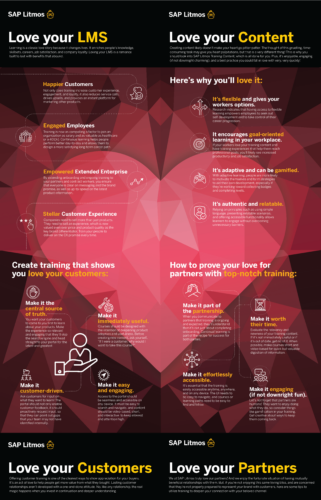For the Love of Learning: Love Your Customers
It’s a great time to be a consumer (in both B2C and B2B) because there are so many innovative, exciting new products available across industries from tech to retail to automotive and everything in between. Whether it’s a new app for your phone, an electric car that feels more like an app on wheels, software that streamlines your team’s interactions, or a washing machine that makes doing laundry feel like fun – you get the idea!
There’s never been a more interesting array of cool things to buy – things that make the “old things” seem really old and simple. How lame does your regular toothbrush look now, next to your sleek, sonically vibrating, app-tracked, wonder-brush that doubles as modern art on your bathroom counter? Honestly, how did we ever even survive without purses that charge our phones and locks that don’t need keys?!?
However, as we explore our February theme of love, let’s be reminded that just like with people, some very alluring offerings can come with a dark side. What may seem simply perfect on the outside may disguise a deeply complex (even confusing) interior. Yes, you may have fallen for the beauty, the intelligence, the uniqueness, but then you get it home or download it or pull it off the lot, and…
Uh oh. How do I learn to interact with this thing?
Welcome to the world of customer training – a category of corporate training that grew as much out of necessity as out of ingenuity. Products these days are sometimes so sophisticated that customers need training on them not only to maximize their usefulness, but also to deepen adoption of and loyalty to them.
The best companies know that providing customer training is one of the clearest ways to show buyers that you see the world from their view, understand their challenges, and appreciate their willingness to want to learn more about what they bought.
It’s an act of love to help people get more value from what they purchased. Lasting customer relationships can’t be developed with a one-and-done attitude: “See ya! Good luck figuring it out.” No, like any relationship, the real magic happens when you invest in continuation and deeper understanding.
How does training demonstrate that you love your customers?
Let me start by saying that we at Litmos do, in fact, love our customers. We deliver the unique customer experience of the Litmos Dojo, which is our online training portal for customers. We use the fun metaphor of a dojo – a room in which martial arts are practiced – to offer them the opportunity to pursue a White, Green, or Black Belt via learning paths designed to take them to whatever level of proficiency, fluency, or mastery that they desire.
Shameless stat: 100 percent of Litmos customers utilize the Dojo for onboarding and about half of those continue with ongoing customer training throughout their journey.
Using the Litmos Dojo as a successful model, why do customers flock to this type of environment for learning? What makes them feel welcome and that it’s worthy of their time, not just as new customers but as long-term users? More importantly, what principles can help you build this type of learning center for your customers?
Here are four tips to create training that proves your love for customers:
- Make it the central source of truth. There’s a saying that in the Digital Age: “There is no not knowing.” Information is instantly discoverable online and when we want to know something, it takes only seconds to dig up whatever we’re looking for.As a rule, you want your customers to come to you first to learn about your products. Sure, in some industries, fans may create useful content and videos to help other customers, but generally speaking, you want your customer training center to be so accessible, current, engaging, and fun that customers need not look elsewhere. Set the precedent that even though they could Google a “how to” query, it will be a better experience for them to head straight to your portal for the latest and greatest.
- Make it immediately useful. Keep your customer portal uncluttered and absent of content that can’t be put to use in the real world. An exception to this rule would be if you have preview course(s) / video(s) that highlight upcoming product enhancements or releases, otherwise all courses should be applicable to how customers use your products now. Courses should be designed with the intention of deepening their adoption and usefulness. Before creating new content, ask yourself, “If I were a customer, why would I want to take this course?” Also, be sure to update content on a very regular basis and remove items that are outdated.
- Make it customer-driven. Here’s a novel idea: ask customers for input on what they want to learn! The portal should not only enable customer feedback, it should proactively request input, so that they can point out gaps that your team may not have identified internally. Sometimes customers use products in ways that the company did not intend, but that doesn’t make them illegitimate. For example, text messaging was originally developed by cell phone carriers to alert customers to network problems; the carriers didn’t expect people to use the capability to send messages to each other. Who knew?!?
Also, take advantage of reporting in your LMS to see what courses are most popular (do more of those!), which ones people abandon, and which ones are not being utilized much at all. You can learn a lot about what’s working and what’s not by incorporating the customer viewpoint into the ongoing plan. - Make it easy and engaging. Accessing the portal should be seamless and without annoying barriers to entry. Of course, this means it’s accessible on any device, and is easy to search and navigate. Use design best practices for high visual engagement, and keep the language simple in introductions and descriptions, so that customers can quickly scan and find the content they want. As mentioned above, it should be as clutter-free as possible without a bunch of outdated content to scroll through. The courses themselves should ideally be video-based, short, and interactive to keep interest and attention high.
Check out our other posts in this series: Love Your LMS, Love Your Content, Love Your Partners.





